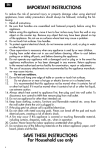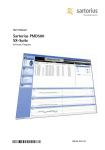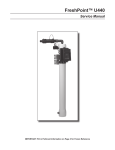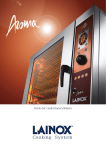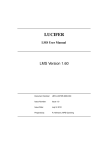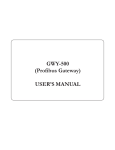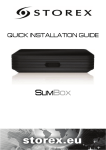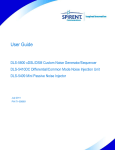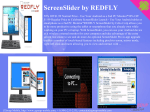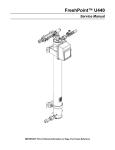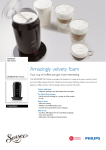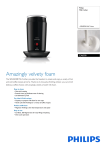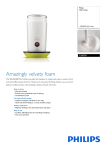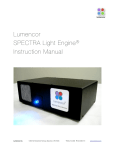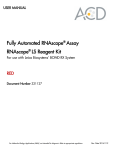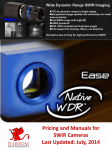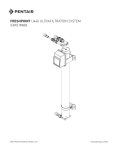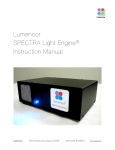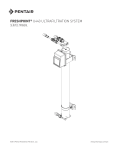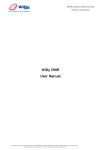Download PMD500: SX-Plus
Transcript
User Manual Sartorius PMD500 SX-Plus V1.4.0 Software Program 98646-003-07 Contents 3 3 3 4 4 1 Revision history 1.1 V1.4.0 1.2 V1.3.9 1.3 V1.3.8 1.4 V1.3.7 5 2 Introduction 5 3 NIR 6 6 6 6 6 6 6 6 6 6 6 6 7 4 Terms & Abbreviations 4.1 Chemometrics 4.2 Regression 4.3 Regression methods 4.3.1 MLR 4.3.2 PCR 4.3.3 PLS 4.3.4 Other methods 4.3.5 Standard -deviation, -errors 4.3.6 Colinearity 4.3.7 Interference 4.3.8 Pre-treatment 4.3.9 Report abrevations 8 8 8 5 Questions & Answers 5.1 How accurate can I measure? 5.2 How many samples do I need to make a calibration? 5.3 Transfer a calibration from one equipment to another 5.4 What to do when it doesn’t work? 8 8 9 9 9 2 6 Collecting data 6.1 Collecting data using a separate ID-List 6.2 Collecting data using SXCenter Journal 10 10 10 10 10 10 11 11 11 11 11 12 12 13 13 13 13 13 13 14 14 14 14 14 14 7 SX-Plus 7.1 Users interface 7.2 Projects 7.2.1 New Project 7.2.2 Saving your Project 7.2.3 Project window 7.3 Files 7.3.1 Adding data-files 7.4 Calculation parameters 7.4.1 Sample selector 7.4.2 Selecting and formatting the target parameter 7.4.3 Standard pre-treatment 7.4.4 Special pre-treatments 7.4.5 Regression methods 7.4.6 Validate 7.4.7 Cross-validation 7.4.8 Auto-Delete 7.4.9 Factors 7.5 Project results 7.5.1 Pre-treat 7.5.2 Modell 7.6 Results 7.7 Graphs 7.8 Export your calibration 7.9 Settings 15 8 Using the calibration 15 9 Calibration maintenance The following symbols are used in these instructions: § indicates required steps $ indicates steps required only under certain conditions > describes what happens after you have performed a particular step – indicates an item in a list ì indicates hazard 1 Revision history 1.1 V1.4.0 - Valid for software V1.5.0 or later - Projects must now be named: *.Parameter.*.prj e.g. Mix.Protein.10-15.prj a warning will be displayed if name doesn’t follow this convention - The project name will automatically change when you select a parameter and start the computation - Clicking a File will automatically add selectors based on values in field “Recipe” - Clicking a file will automatically add existing parameters and their range - AutoDelete function has been moved into project and overrides any settings in the Options. Format is “Calibration Mahalanobis Validation” - Calibration of classes using “*” now automatically creates a usable calibration file upon export - You may now denote files as #1, #2, #3 and #4. This will load the exported journal files from the respective instrument - Any field named “Recepies” will be renamed to “Recipes” - The AutoDelete function did sometimes not work properly, problem fixed - License entering dialogue is now visible in the task-bar. - A zoomed Wavelength graph now has the capability to display component absorbance lines. Components can be modified in file Bands.txt located in the install folder - Upon export and overwriting of a calibration file only year-month-day is used; this means that only one calibration per day is traceable. Traceable file is only created ones - In the Mahalanobis / Residium and Spectral graph the sample reference rather than ID is used when a item is selected in the graph - Removed the need to right click the graph to get selected objects into the clipboard 1.2 V1.3.9 - Relevant for SX-Plus V1.4.3 or later - Corrected graph of Residuals - Cross validation option is now stored in the project - A Project using option validation or cross validation will export without checking number of factors. Model factors are defined by minimum validation or cross validation error - Cross validation can be maximized for large data sets resulting in leaving out more than one sample for each cross validation. E.g. setting 30 creates 30 subsets for validation; sample ID is persistent across validation groups 3 - Fixed condition when saving Project to new location and creating local copy of data - Default graph using cross validation is CVEstimates - When saveing a project matrix, dialog title has been changed to “Save Matrix…” - Project is now blocked for changes when computing the model - Incomplete editing of project settings when starting the calibration process are automatically completed. 1.3 V1.3.8 - Relevant for SX-Plus V1.4.0 or later - Corrected import of ISI exported data - Chapter 7.4.2 Note on range limit - Note to check Bias removed 1.4 V1.3.7 - Relevant for SX-Plus V1.3.124 or later - Correction of table of content - 7.4.2 Corrected missing semicolons - 7.4.4 Added OSC,EMSC,X2/X0.5 - 7.4.6 Added option 9:-3 4 2 Introduction 3 NIR Prior to using NIR it is necessary to create a calibration; this calibration re-computes the measured spectrum into a desired property. The creation of a calibration model is not equal to the adjustment of intercept and slope, though this i soften referred to as „calibrating the unit” Applying NIR spectroscopy is based upon physical fact that causes energy of certain wavelength to interact with atom to atom bonds. These bonds are brought into vibration causing selective absorption along the wavelength axis. The amount of energy converted is proportional to the concentration of this molecule bond. Thereby a measurement of the chemical composition is possible. NIR is a secondary method, thus it in almost all cases require prior knowledge of the composition of the samples measured in the calibration development phase. To create a calibration model the samples are anlaysed using the NIR spectrometer as well as applicable primariy methods. In most cases a calibration is used to determine a concentration property e.g %Moisture or %Protein. In some cases the sample is classified as Type, Good or Bad. To develop a calibration the samples need to cover all future expected variations – not only in the target properties but also other such as sample temperature or particle-size. Since a molecule is build of a plurality of bonds it is necessary to measure more than one wavelength to analyse the sample. These molecules are also subject to measurable changes due to e.g. temperature. Measurement in different wavelength regions causes different pros and cons. Measurement above 2.5um causes the bands to be well separated and a relatively small sample set may be used for calibration; the con is that the penetration depth of these wavelengths is low and that the sample needs to be prepared prior to measurement by extraction using a solvent or grinding the sample – this makes long wavelength non suitable for on-line analysis. The shorter wavelengths suffer from more interference requiring a larger sample set for training; the pro is that the measurement may be conducted without sample preparation – suitable for online analysis. 5 4 Terms & Abbreviations 4.1 Chemometrics Is an expression often used in conjunction with NIR. It signifies the interpretation of spectral data to determine chemical composition with the use of mathematical methods. 4.2 Regression Is a mathematical term for solving an equation for its un-knowns. 4.3 Regression methods The mathematical or procedural way by which the equation is determined. 4.3.1 MLR Abbreviation for „Multiple Linear Regression“. Is the most common method of solving equations where you have many variables that in a linear combination represent the target. Various methods are use depending on numerical and stability properties of your data, SVD (Singualr value decomposition) or RR (Ridge Regression). 4.3.2 PCR Abbreviation for „Principal Component Regression“ – This method is a combination of data-reduction and MLR, where by the data is approximated by a fewer number of variables that are later used to solve the equation. 4.3.3 PLS Abbreviation for „Partial Least Squares“, is the most common method applied to calculate calibration models. This method is similar to PCR though the eigenvectors are calculated to maximize the covariance to the target / target residuum. 6 4.3.4 Other methods There is a long list of other methods used in special cases where MLR/PCR/PLS fails to produce a satisfactory result. Examples ANN (Artificial Neural Networks), LWR (Locally weighted regression), SIMCA (Soft independant model of classes – specialized PCR) 4.3.5 Standard -deviation, -errors Standard deviations are often used to determine the quality of a model. Given a normal distribution the value represents the spread of 68% of the population examined. 4.3.6 Colinearity Colinearity can be viewed as redundancy in the data where many of the observed variables are a linear combination of them selves; this can also be seen as an ambiguity in solving the equation since many solutions give approx. the same result. Extreme colinearity will in many cases lead to a poor model; in these cases you will need to select the appropriate wavelengths by some means. 4.3.7 Interference Term that a measured signal is disturbed. 4.3.8 Pre-treatment Pre-treatments are mathematical roformating functions of the original measured signal; these are sometimes need to e.g. cancel particle size effects. 4.3.9 Report abrevations In the report window SX-Plus lists various number these are: 7 5 Questions & Answers Applying NIR and before applying NIR as a measurement method many questions are raised prior to use. Some can be answered directly but a majority need to be included as a part of the assessment of the method. 5.1 How accurate can I measure? This is probably the most frequently asked question. Unfortunately there is no exact answer since there are many parameters that affect the answer. If we separate the answer two measuring subtances that are known to absorb in the measured region, e.g. Protein/ Moisture or Fat. It is often found that the measurement accuracy is equal to the reference method error. One should however always conduct a study and determine the error for each application since other effect as impurity; sample presentation may have significant effect on the accuracy obtained. 5.2 How many samples do I need to make a calibration? A round number is 100, and this i soften not a bad number of needed samples. Again the complexity of the sample composition determines the actual number of needed samples. An estimate can be calculated by taking 20 samples with various concentration covering the future expected range and adding 3 samples for each expected disturbance (variation of other parameters that should not cause change in estimate). To optimize your model you will need a further 10 samples plus 3 samples for each disturber and a further set of at least 20 real samples to validate your model. In 8 total you will calculate the need for about 100 samples. 5.3 Transfer a calibration from one equipment to another The accuracy obtained when a calibration is transferred is one of the most important properties – this is partly affected by instrument to instrument differences as well as the inner properties of the calibration. In general a calibration that works good will transfer – a calibration that works poor (due to inner properties) will not transfer. It is often a benefit if the calibration is developed using data from more than one instrument; A transferred calibration often needs a new defined intercept since this property isn’t a part of the calibration model. 5.4 What to do when it doesn’t work? - Reference values: Determine the error of your reference values by sending same sample to your laboratory with different names. - Sampling: Validate that your sample corresponds too your spectra; are the sample uniquely identified? 6 Collecting data Measurements made using SX-Center can directly be exported and used from withing SX-Plus. Samples analysed in the „Today-View“ require a separate ID file where the target values of the samples are defined.Using the Journal of SX-Center enables the user to enter the reference values directly and export a table of data contining all necessary data for calculation. 6.1 Collecting data using a separate IDList 1. Start SX-Server 2. Configure sample recognition 3. Start SX-Center 4. Create a Recipe 5. Measure the samples and enter ID’s 6. Export the data 7. Create a Tab separated file using excel with reference values 6.2 Collecting data using SX-Center Journal 1. Start SX-Center 2. Select Journal 3. Enter target values 4. Select entry for begin of export 5. Export the data 9 7 SX-Plus 7.1 Users interface 7.2 Projects SX-Plus maintains all data in project files. The project file contains references to other files for e.g. calibration data and ID-List. It is recommended to store data in subdirectories relative to the location of the project file; in this way you may easily copy data from one location to another e.g. create a backup on a server. 7.2.1 New Project To create a new project select „File“; „New“; in the main menu. A Empty project is created named „Project1“. Allways begin by saving this project to a desired name. 10 7.2.2 Saving your Project You may save the project by selecting any item in the project window and click the save button. You may also save it under a different name by selecting „File“; „Save As…“ in the main menu. 7.2.3 Project window The project is displayed as a tree. Each entry is defined by its location and/or its description showed behind each entry in parentheses. A entry is only regarded if the check-box is checked. To edit an entry select the entry text with a single left mouse-click; pause and click again; a entry box will be displayed. Some entry’s will also show a dropdown box with predefined entries. 7.3 Files 7.3.1 Adding data-files Files a new entry By double-clicking is created. By double clicking an entry you may select a file to use. By singleclick on an entry the file will be displayed in the Table window. 7.4 Calculation parameters There are a number of settings that control the way your date is computed. The following are the minimum used: 1. (Query) Defines the mask used to query the data in your data-tables. 2. (Y) Defines the target parameter 3. (Pretreat1) Basic pretreatment1 4. (Pretreat#) Optional further pretreatments 5. (Type) Regression method 6. (Validate) Samples used to validate your model 7.4.1 Sample selector The selection of samples is defined by a query. A field in each Table is compared to a mask. The following examples apply: - Recipe = Salt selects all samples that have been measured with the Recipe „Salt“. - Recipe = * selects all spectra’s - Recipe = *[anr]* selects all spectra’s measured with Recipes containing an a, n or r. 7.4.2 Selecting and formatting the target parameter The target parameter can be defined and formatted in the following way: - ID Protein 0 100 0.0% Target values are read by comparing the data-tables ID field with your ID-List, values in the field „Protein“of your ID-list defines the target. Output is formatted with one decimal digit followed by a percent sign. - Moisture 10 20 0.00% Targets are selected from your data-table in the range of 10 to 20. Output is formatted using 2 decimal digits followed by a percent sign. - Ash 0.3 0.5 0.5 0.9 0.000% Target is defined by the field „Ash“ in your datatable. The calibration defines two zero levels; one for samples between 0.3 and 0.5 and one for samples between 0.5 and 0.9. Output is formatted with 3 decimal digits. - Class 0 4 ?;Flour;Wheat;Durum;? The field „Class“ in your data table is used to define targets – Flour will be represented by a numerical one, Wheat by 2 and Durum by 3. - Class 0 4 ?;Flour;Wheat/Durum;? The field „Class“ in your data table is used to define targets – Flour will be represented by a numerical one, Wheat and Durum by 2. Note. Range limits must be formatted using a decimal „.“ not comma, independent of regional settings! 11 7.4.3 Standard pre-treatment The elements of a diode array are statically aligned along the wavelengthrange of the spectrometer. Therefore it is required to recompute the absorbencies determined by measurement to a fixed scheme and allow combination of data from several units and transfer of a model from one equipment to another. This pretreatment is mandatory. - SNVT Subtracts the average and divides by the standard-deviation of the vector. Example: Spline2 #1 #2 #3 1050 1750 10 Recalculates the measured spectrum to a vector representing the absorbencies from 1050 to 1750nm with a spacing of 10 nanometres. - OSC Computes a model of the data that is perpendicular to the modelling target and subtracts it from the observations 7.4.4 Special pre-treatments Mathematical pre-treatments are used to reformat / reshape the data. These can effectively be used to cancel out unwanted effects such as physical properties (e.g. particle-size) and to linear-rise the response. Correctly applied pre-treatment often yield a more precise and robust model. - EMSC 2 Computes a second order fit of the means spectrum to the spectra and remove it from the data - NOIMAGE Removes image data from the observations if present - MEAN Subtracts the mean of your vector - SMOOTH 2 Smoothing over 5 data-points along each vector - DG 1 5 3 Computes first derivative using 5 data-points and a smoothing window of three data points - DG 2 3 5 Compotes second derivative using 3 data-points and a smoothing window of five data-points 12 - AVG Calculated the average of repeated measurements. Repeated measurements hold same sample ID - AVG 2 Calculated the average of two consecutive x and y values irrespective of sample ID - EMSC 1 Computes a second order fit of to the spectra and remove it from the data - X2 X0.5 Power transformation 7.4.5 Regression methods Determine the regression method. Examples: PCR - Standard PCR-Method 7.4.7 Cross-validation Determine the number of sections to divide the calibration set into where each section is left out once in order to determine statistics for these left out samples during regression. PLS - Standard PLS-Method PLS2 - Standard PLS2-Method 7.4.8 Auto-Delete Determine what samples to remove from the calibration and validation data. XLS - PLS with second derivative RR - Ridge Regression (MLR) If a plus sign is added to the method the software will automatically select significant wavelengths (68% Relevance) for each factor. E.g. PLS+ or RR+ , a double plus E.g PLS++ will select 95% relevance, a tripple plus is not supported. 7.4.6 Validate With this setting you determine the samples used to optimize / validate the calculation during model development: 2 - Selects every second spectra for validation 4:2 - Selects 2 samples in each group of four samples for validation 9:-3 - Selects the last 3 samples in a group of nine for validation 3 25 4 – Removes any samples from the calibration data with a standardized residual larger than 3, removes any sample from the calibration or validation data with a Mahalanobis distance larger than 25 and any samples in the validation data with a standardized residual larger than 4 Note: When using Automatic recalibration these deletes are non persistent; thus reevaluation will occur upon each recalibration 7.4.9 Factors Determine the number of factors for your model. Leaving this option „unchecked“ during calculation will lead the software to optimize the number of factors to use. 7.5 Project results Results of the computations can be viewed as a numerical table or graphically by selecting one of the bold entries in the project. -10 - Selects the last 10 spectra for validation. 13 7.5.1 Pre-treat Pretreat Wavelengths Vector of used wavelengths SNRs Vector of instrument serial-numbers WLCs Vector of instrument wavelength calibrations Means Matrix of spectral means for each data-set Variations Matrix of variance for each data-set 7.5.2 Modell Wavelengths Vector of used wavelengths Indexes Vector of references to used samples IDs Vector of sample ID’s Center Average Target Target Vector of Target Zero Vector of mean spectra Observations Matrix of spectras Weights Matrix of projected X-values Loads Matrix of projected Y-values Regressions Matrix of regression vectors Press 2 Vectors representing residuum for calibration and validation Scores Estimated Y - values Bias Zero levels. Estimates Estimated Target values Residuals Residuals of estimates IDResiduals TEstimates Estimates over time TResiduals Residuals over time Validation In this group you find above entries for your validation data 14 7.6 Results By selecting „Compute“ from the main menu the results of the computation is shown in the report window. This report discloses information about used data, statistics and possible abnormalities. 7.7 Graphs By selecting various matrices/vectors in the project the data is graphically displayed. 3D graphs may be rotated by holding down the left mouse button and moving the mouse. By holding the „Ctrl“ down and clicking with the left mouse button references can be selected. By clicking the right mouse button still holding the „Ctrl“-key down copies these references to the clipboard. To e.g. delete the marked sample – enter the delete leaf of the project and paste the sample references. If not samples have been selected – clicking the right mouse button will copy a „white“ background graph into the clipboard. This may be pasted into Word or Excel. 7.8 Export your calibration From the menu select „Project“ / „Export…“ Select a location and enter the name of your calibration. It is common practice to keep a version number, parameter name and range. 7.9 Settings Further settings can be modified selecting „View“ / „Options“ from the main menu 8 Using the calibration 9 Calibration maintenance To use the calibration, place them in the „Calibrations“ folder of your SX-Suite installation. It will automatically appear in the list of available calibrations when you edit a Recipe. It is in the beginning often necessary to add data to an earlier project. Open the project, select the data table. From the menu select „File“ „Merge…“ and select the file containing the new data. The new data will be added to the end of the table. Re-compute and export the model. 15 Sartorius AG Weender Landstrasse 94-108 37075 Goettingen, Germany Phone +49.551.308.0 Fax +49.551.308.3289 www.sartorius.com Copyright by Sartorius AG, Goettingen, Germany. All rights reserved. No part of this publication may be reprinted or translated in any form or by any means without the prior written permission of Sartorius AG. The status of the information, specifications and illustrations in this manual is indicated by the date given below. Sartorius AG reserves the right to make changes to the technology, features, specifications and design of the equipment without notice. Status: August 2009, Sartorius AG, Goettingen, Germany Printed in Germany on paper that has been bleached without any use of chlorine. W1A0OO - KT Publication No.: WPM6071-e09082
















